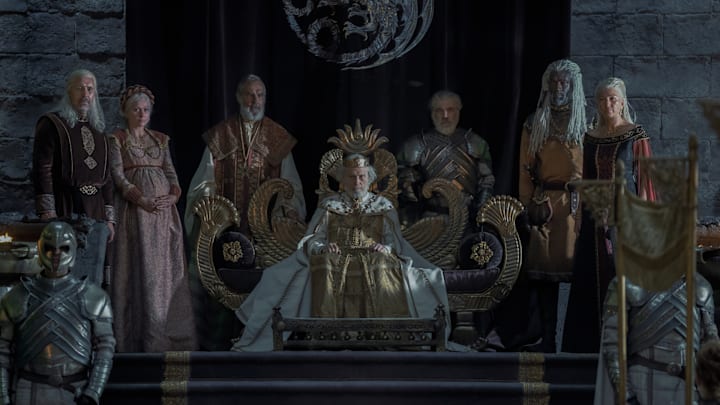To the best of our knowledge, the Middle Ages weren’t crawling with ice zombies, dragons, and platinum blonde wigs. But despite these creative liberties, the medieval fantasy Game of Thrones has always had a foothold in history—as evidenced by the iconic “Red Wedding” episode, which drew heavily from actual Scottish massacres. According to George R.R. Martin, author of the A Song of Ice and Fire book series, the latest installment in the GoT universe, HBO’s prequel series House of the Dragon, draws from real-life events, too. More specifically: from a violent time in 12th century England that pit the king’s nephew against a princess.
Martin revealed these story origins at Comic-Con this past summer, explaining, “Game of Thrones, as many people observed, was based loosely during the English’s War of the Roses. This show was based on an earlier period in medieval history called The Anarchy.”
A King in Crisis

The Anarchy was a succession crisis concerning King Henry I, who ruled England from 1100 to 1135. Henry married Matilda of Scotland the same year he ascended the throne, and his queen soon bore two children: Matilda and William. (He also had many illegitimate children, but we’ll get to that later.)
With a healthy heir, Henry could rest easy and rule, but twin tragedies struck the royal family about halfway through his reign. First, Queen Matilda died in 1118. Then, in 1120, William boarded the fateful White Ship out of Normandy. According to the British Library, the 17-year-old prince and other young royals onboard started drinking, roping the sailors into their mischief, and before long the impaired crew had rowed right into a rock. The ship sank, leaving only one survivor—a peasant—and England without a male heir.
Like his House of the Dragon counterpart Viserys Targaryen (played by Paddy Considine), Henry I panicked and married a much younger woman, hoping to produce another baby boy. But unlike Viserys and Lady Alicent Hightower, Henry and Adeliza of Louvain did not have any children. So in 1127, the king called on his court to swear loyalty to his daughter Matilda as heir to the throne. They complied, but when the king died in 1135, many broke this promise.
The Court and the Countess

The court instead threw its support behind Stephen of Blois, the king’s nephew. Stephen had been part of the court since childhood, and had only strengthened his standing through his marriage to the wealthy Countess of Boulogne. As scholar Robert B. Patterson notes, Stephen was one of the royals who swore allegiance to Matilda—some accounts even claim he fought for the honor of being the first to do so—but he also understood that many powerful men doubted a woman’s ability to rule. He seized on this sexism, and was crowned with the pope’s blessing.
Matilda, however, would not take this slight without a fight. Now going by Empress Matilda, thanks to her marriage to the late Holy Roman Emperor Henry V, the spurned princess formed a crucial alliance with one of Henry I’s illegitimate sons: her half-brother Robert of Gloucester. As support for Stephen wavered, she ordered her army to invade England in 1139. The fighting would continue for roughly a decade, as castles were captured and allegiances flipped among nobles and the clergy.
When Stephen was taken prisoner in 1141 at the Battle of Lincoln, Matilda appeared poised for glory. But as she planned her coronation in London, the city rose up against her, and she was forced to not only abandon the ceremony but skip town entirely. Her armies eventually released Stephen in exchange for their captured ally Robert. And thus, the war raged on.
A Promise Kept—at Long Last

Finally, in 1148, Matilda withdrew from the conflict by retiring to Normandy with her second husband, the Count of Anjou. She would live out the rest of her life in France, effectively abandoning her dream of ruling England for good. Though the war hadn’t officially ended—the country was still in disarray—Stephen had, in her absence, claimed a victory.
But Matilda had the last laugh.
Despite her cousin’s attempts to secure the throne for his sons, Stephen signed the Treaty of Wallingford in 1153 under immense pressure from his court. It named Matilda’s son Henry as the true heir to the crown, a title he claimed the following year when King Stephen died.
